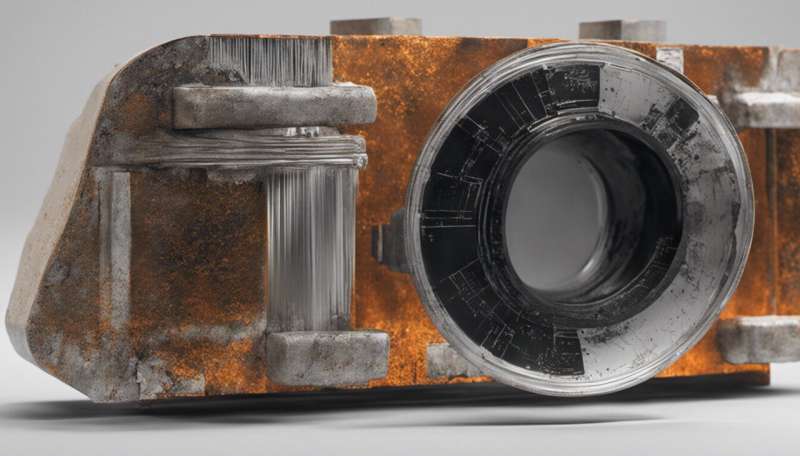Metallurgist explains the surprising properties of aluminum

Despite being the most abundant metal on Earth, constituting over 8% of the Earth’s core mass, aluminum was only discovered in the 1820s, by Danish physicist Hans Christian Ørsted. This is partly explained because pure aluminum doesn’t exist in nature as it binds easily with other elements like oxygen.
Our main source of aluminum is the sedimentary rock, bauxite. As Van der Eijk explains, “It takes about four kilos of bauxite to produce one kilo of aluminum metal. After mining the bauxite ore, aluminum oxide is extracted. Then, the aluminum and oxygen are separated by an electric current passed through a molten solution of alumina and the mineral cryolite, which dissolves the oxide minerals.”
It wasn’t until towards the end of the 19th century that aluminum was produced at an industrial scale, and its properties proved invaluable. It is lightweight—about a third the weight of steel. “It is also soft and malleable, so can easily be cast or formed into many different products,” adds Van der Eijk.
It has been routinely used in packaging (in cans and for aluminum foil), consumer goods (such as phones and PCs), transportation (cars, planes, ships and trains) and power lines, being cheaper than copper and with a better conductivity to weight ratio.
And it doesn’t rust?
It turns out that this is a misconception.
When iron is exposed to moisture and oxygen, it becomes caked in the brown-red brittle substance we call rust. As steel is an alloy, with iron its principal ingredient, it also rusts.
While other metals corrode when exposed to oxygen or water, they don’t actually rust. Think of the thin green layer that forms on the domes of buildings made from copper, brass or bronze.
“Aluminum reacts very quickly to oxygen, creating a thin layer of aluminum oxide on its outer surface, which stops more oxygen from reaching the metal, so protecting it,” explains Van der Eijk.
This, however, doesn’t make aluminum invincible.
Contact with salt water can result in small holes, known as pits, and it will corrode if exposed to alkaline environments, but is more resilient to acid, able to withstand soft drinks with a pH less than three.
“So it’s not suitable when combined with wet concrete. When Portland cement is hydrated with water to make concrete it produces very alkaline calcium hydroxide, which can cause the aluminum to crack,” Van der Eijk notes.
A bright shiny future?
Aluminum can be infinitely recycled with limited materials loss. Indeed, according to Recycling World: “This property of infinite recyclability has led to a situation where today around 75% of the almost one billion tons of aluminum ever produced is still in productive use.”
It can also be used to replace less sustainable building materials when they reach the end of their life cycles, with Recycling World adding that “It requires up to 95% less energy to recycle aluminum than to produce primary metal and thereby avoids corresponding emissions, including greenhouse gases.”
Additionally, it is an ideal material for building the infrastructure, such as solar panels and wind turbines, of the green energy transition. It also remains attractive for transport, as reduced vehicle weight also decreases emissions.
However, questions remain about the sustainability of its production.
“Currently, every kilogram of aluminum metal produced creates over one kilogram of red mud, which ends up as landfill. And electrolysis should be done without CO2 emissions,” remarks Van der Eijk.
Indeed, Van der Eijk’s project ENSUREAL set out to achieve exactly this. ENSUREAL tweaked the standard Pedersen production process to accept lower grade ores, while also substituting carbon materials with hydrogen, and fossil carbon materials with biocarbon ones, all the while creating useful by-products, such as building materials.
“Aluminum has long been dubbed ‘the green metal’; while it doesn’t fully live up to this yet, I’m confident that it remains key to the circular economy,” concludes Van der Eijk.
More information:
Zero-waste production of alumina in Europe: cordis.europa.eu/article/id/44 … of-alumina-in-europe
Citation:
Metallurgist explains the surprising properties of aluminum (2022, December 2)
retrieved 2 December 2022
from https://phys.org/news/2022-12-metallurgist-properties-aluminum.html
This document is subject to copyright. Apart from any fair dealing for the purpose of private study or research, no
part may be reproduced without the written permission. The content is provided for information purposes only.
For all the latest Science News Click Here
For the latest news and updates, follow us on Google News.

